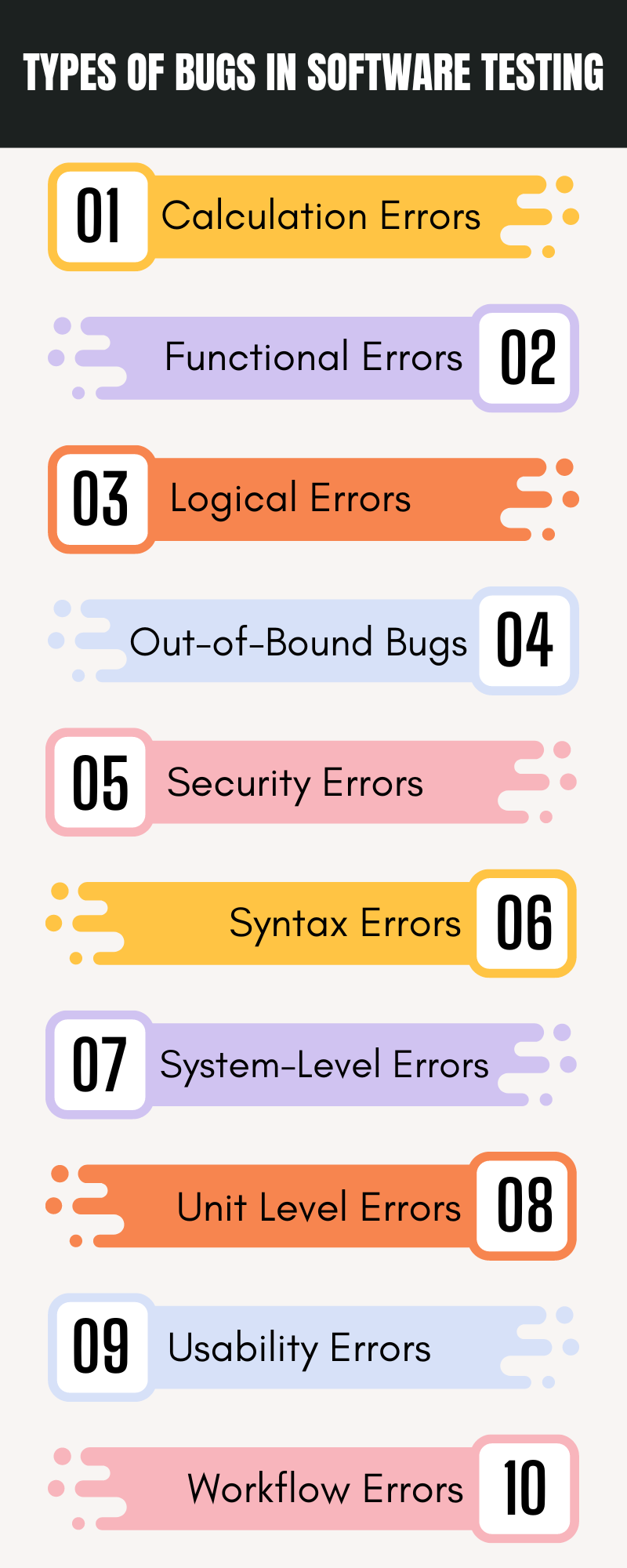10 Types of Bugs and Errors in Software Testing. Software development is not an easy task. It is a complex process, where the development team has to undergo several phases to develop fully functional software.
Starting from gathering the client's requirements to designing, developing, testing, and maintaining, all these phases come together to assemble a full-fledged software. And among all testing plays an important role.
It helps in identifying the bugs and loopholes in the software to ensure quality and performance, which in turn facilitates enhanced customer experience.
So, in this article, we will be listing the different types of bugs that you might come across while developing an application. But, before that let us tell you what bugs in software testing means.
What are Bugs in Software Testing?
Bugs in software testing is an informal/common name for unknown errors, defects, glitches, or loopholes that might lead to unexpected results or the malfunction of an application.
Bugs and errors in an application can occur due to several reasons.
The probable reasons include mistakes while writing the source code, missing code, errors while interpreting the business requirements, and several other factors, which might lead to project failure or being prone to cyber-attacks.
Bugs are not simple at all. Further, bugs are classified into different types.
10 Different Types of Bugs and Errors in Software Testing
Here is the list of 10 types of bugs and errors in software testing.
-
Calculation Errors
-
Functional Errors
-
Logical Errors
-
Out-of-Bound Errors
-
Security Errors
-
Syntax Errors
-
System-Level Integration Errors
-
Unit Level Errors
-
Usability Errors
-
Workflow Errors
Calculation Errors
It is a type of error where the software returns with incorrect values and usually happens because of wrong logic, incorrect formula, data type mismatch, function call issues, etc.
This type of error can cause a lot of problems for businesses. For example - in the banking industry if calculation errors take place then it might lead to a loss of capital from the customer’s bank account.
Functional Errors
This bug affects the functionality of an application or the way software behaves. These types of bugs are detected during the functional testing of an application.
An example of this type of bug in software testing is - the login button not allowing one to log in to certain software, the save button doesn’t save a file, and many more.
Logical Errors
This type of bug might highly affect an application, if not detected early. It mainly happens due to coding errors, or mistakes in the code, thus leading an application to get stuck and even app crashes.
For example - when you want to multiply two numbers but the software adds it, resulting in an unwanted output.
Out-of-Bound Errors
This usually happens when the users try to interact with the software in unexpected ways, or the user searches for a parameter outside the limits of intended use.
For example - significantly entering a larger or smaller number of an undefined data type.
Security Errors
This is one of the most harmful errors that may have major consequences and cause a lot of damage to the business and its customers. This type of error makes an application vulnerable to cyber attacks and allows hackers to gain unauthorized access to the software.
It also leads to sensitive data theft and breaches, which might even put people’s lives at risk.

Syntax Errors
It is one of the most common bugs in software testing and is easy to detect and fix. This type of error usually happens due to human negligence where there is an incorrect or missing character in the code, thus affecting the code compilation.
For example - a missing bracket or a missing comma is enough to derail the program.
System-Level Integration Errors
It usually happens when there is a mistake in the interaction between two or more units of code. This type of bug fixing is a complex task since the bug is difficult to track, there are compatibility issues between two or more components, and also when the code is written by different developers.
Examples of system-level errors include byte-swapping, message parsing, and many others.
Unit Level Errors
It is also one of the common bugs in software testing and this type of testing should be done from the initial stage of coding. It is the smallest part of an application that is to be tested. This error has no particular type but incorporates different types of bugs like state-machine problems, fundamental logic bugs, and many others.
Usability Errors
As the name suggests, it affects the usability of an application. It is an easy-to-detect bug but makes an application complicated for the users thus negatively affecting the user experience.
Examples of usability errors include difficulty in navigating inside the software, hard-to-access content, long and frustrating user onboarding procedures, and many others.
Workflow Errors
It affects the user navigation in an application. It is a series of tasks lined up accordingly to achieve the desired results.
For example - suppose a user fills out a form and if he clicks on “Save and Exit” that means he wants the information to be saved before exiting the application. However, what happens in this type of error is that the “Save and Exit” button leads the user to exit the application, thus causing a workflow error.
Wrapping It Up
Software testing plays an important role and helps in detecting and eliminating errors at an early stage, which in turn helps in providing better and enhanced services to the user.
And if you are thinking to develop an application or software for your business, then you can consider the aforementioned list to detect and fix the errors and deliver top-notch services through the software.
FAQs
What is Software Testing?
-
Software testing plays an important role in the software development life cycle. It is the process where the errors and bugs are identified and fixed to ensure that the software is performing according to the client’s requirements.
What are the benefits of Software Testing?
-
The advantages of software testing include -
-
It helps in customer satisfaction.
-
It is cost-effective and ensures a quality product.
-
It makes an application reliable with low chances of failure.
-
It helps in early error detection and speeds up the development process, and
-
It also enhances the security of the software.
-
What are the best software testing tools?
-
The best software testing tools include Acunetix, Apache JMeter, Cucumber, Katalon Studio, Lambda Test, Selenium, SOAP UI, TestComplete, and many others.

